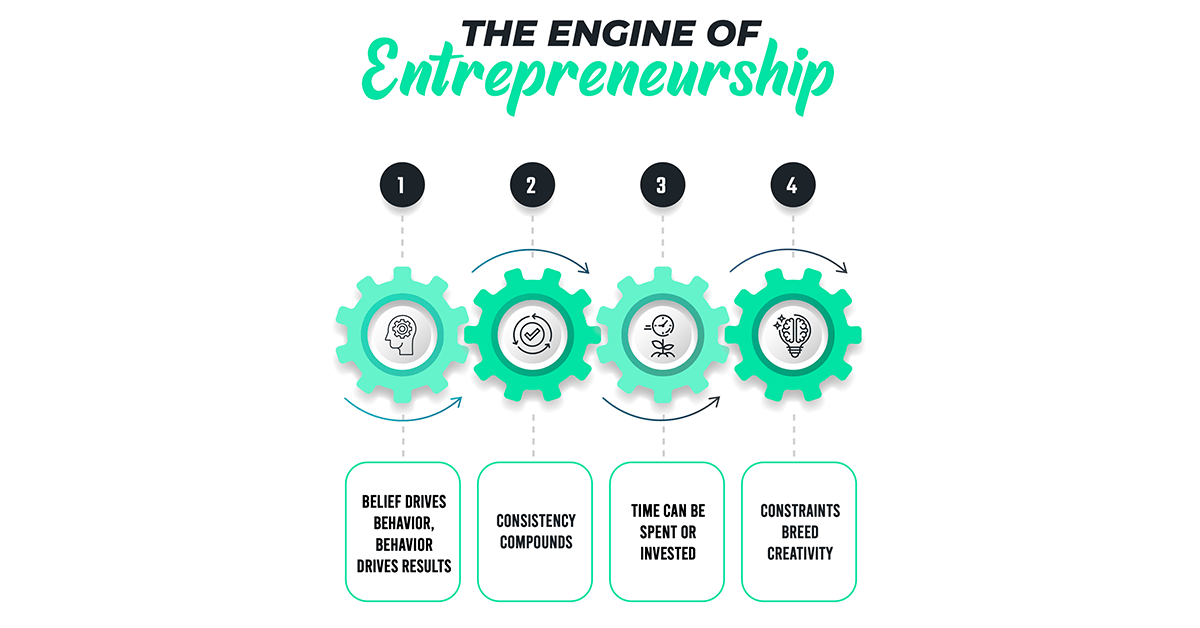June 17, 2024
Principles are statements of truth that transcend circumstance and as a result, it is imperative that educators work to not only point out principles for our students, but also teach students to leverage these principles in their lives.
I’ll cut to the chase—principles are those invisible forces that are always at work regardless of our acknowledgment of them. They are like gears that grind ceaselessly and they can either work for us to greatly impact our lives or they work against us to lead us toward failure. It all comes down to our acknowledgment of how they work.
The space of entrepreneurial education is ripe for the identification of principles because it is a space that depends so fully upon taking action. When in doubt, the entrepreneur must be biased for action and must be willing to take a calculated risk in favor of a positive return. And identifying the underlying principles can help offset the risk.
But identification is only the first step—it must be followed by implementation. Recognizing that the principle is present is important, but the principle will continue to operate and must be leveraged to bring benefit to the individual or the project. An example is the compounding principle—every single thing we do adds up over time to define who we become and our overall level of success. This can work for us (become healthier and happier) or against us (lose our health and sense of purpose) but once we identify the principle and how it works, we are better poised to use it to our advantage.
There are four guiding principles in entrepreneurship education that should not only be recognized but should also be embraced, taught, and practiced. The practice of recognizing principles involves identifying the principle for the students and then explaining how it operates. By doing this over and over, we ingrain not only the principle but also a mindset of principle-based thinking. Out of this, we help our students grow in wisdom.
Principle One: Belief Drives Behavior and Behavior Drives Results
All too often in our society we fixate on results and grow impatient if the results we desire are delayed in coming. Results, however, stem from behavior and in order to create the behavior that drives the desired results, we need to examine our beliefs. If we believe that engaging students in the entrepreneurial mindset is a worthwhile pursuit, our behavior will drive the results. If we have limited or fixed beliefs, however, it will lead to a lack of behavior which will not drive the necessary results. Start with beliefs to establish behaviors to craft results.
Principle Two: Consistency Compounds
There is no lasting entrepreneurial mindset without an understanding of compounding—whether it be understanding compound interest (what Einstein called the “8th wonder of the world”) in financial literacy or the role of habit formation in goal setting, compounding is the primary determining force behind success or failure. As Atomic Habits author James Clear says, “Every action you take is a vote for the type of person you want to become.” In my own experience, students crave knowledge around compounding, and lessons on compound interest that showcase steady growth over time go over amazingly well.
Principle Three: Time Can Be Spent or Invested
Time is truly our most precious resource, and we can be intentional about its usage. The default setting is to spend our time, but with focus, we can learn to invest it—investing carries with it the connotation of expected return, and when time is invested, the return is often magnified. This can impact our health, our relationships, our finances, our intellectual growth, our spiritual well-being, and our occupational status. When we invest our money, we hope for more money as a result; when we invest our time, we can hope for more time and time of greater quality.
Principle Four: Constraints Breed Creativity
There are few certainties in life and education, but one is certainly clear: we will face constraints. These constraints may range from not enough time and not enough money, to not enough resources and too few people, but there is a guarantee that we will not only face constraints but that they will be ongoing. This is especially true for schools. The beauty of this principle is it enables us to embrace the constraint and see it as an opportunity to get wildly creative and think so far outside the box that we forget the box even exists. This sort of thinking can supercharge not only a class but an entire school culture.
When we, as educators, become principle-focused, we inevitably help students identify how these principles work. Once they are identified, students are able to leverage the principles to reap enormous growth in all areas of life. This is how education can move from the theoretical to the practical and make real and lasting difference in the lives of students—a pattern central to the spirit of entrepreneurship and the entrepreneurial mindset.
The Future of Education is Bright Indeed!
Want engaging ideas around entrepreneurship education at your school? Sign up for my newsletter here: https://seedtreegroup.beehiiv.com/subscribe
You may also be interested in reading more articles written by Stephen Carter for Intrepid Ed News.

